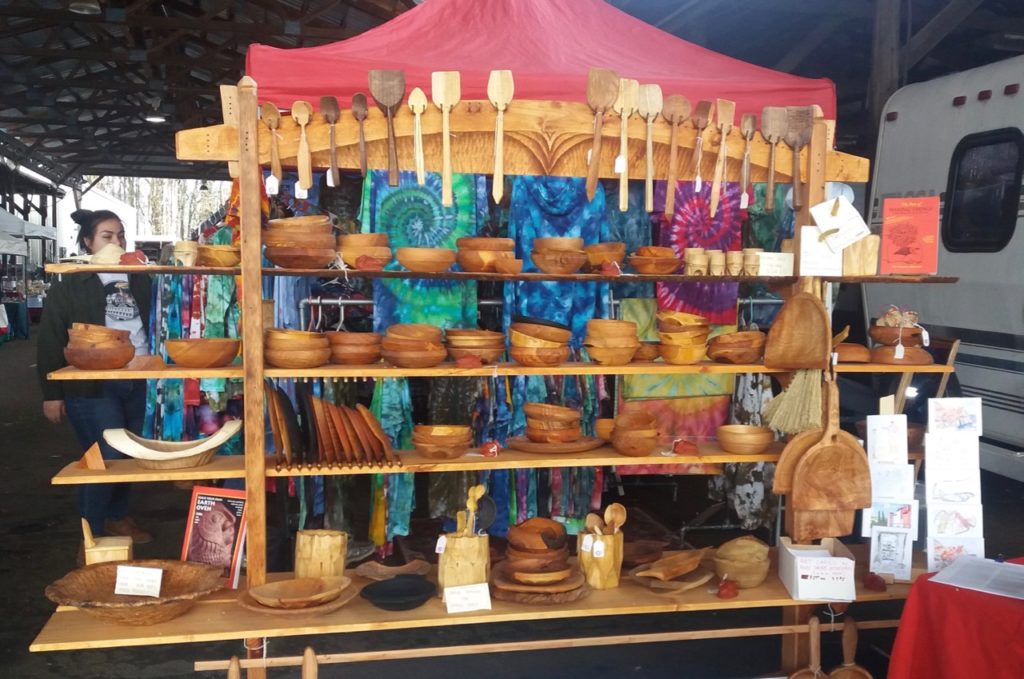
- May 18-19, cob oven workshop at the Artisan Baking Center in Petaluma California, details here
- June 22-23, cob oven workshop at the Prairie Mountain Folkschool in Joseph, Oregon, details here
- August 17-18, A two day Greenwood Carving class (from simple to more complex), at the Sitka Center for Art and Ecology, Otis, Oregon, details here
- June & August Greenwood Spoon Carving classes, dates TBA, Corvallis Art center, Oregon, details should be posted here soon!
- July 21-27 I’ll be teaching greenwood spoon-carving at Echoes-in-time, another primitive skills gathering just outside of Monmouth, Oregon. Like last month’s Acorn Gathering, it’s a wonderful week-long event where you can learn everything! Details here. (If these dates don’t work for you, here’s a page with an extensive list of other events all over the country.)
- I’ve been posting on Instagram — pix, little stories, local events, works-in-progress, etc. I’m hoping it might become a way to stay in touch, especially w/neighbors and nearby folk: @hand.print.press
- Hannah and friends have started a local (Corvallis area) shape note/sacred harp singing group, which is open to anyone who likes to sing (loud!) twice a month — no experience required. Details here.
- I’m talking to other local wood-workers and crafts folk about ways to provide local wares from local wood for local needs. Our December craft fair is part of that, and the Corvallis Winter Market, where Eben and I have been selling wares. We might try to make the summer market too, when we’re not doing other things. Let me know if you want to be on the list for the winter craft sale.
- Later in the summer, or in the early fall, I’m hoping to help friends host a week-long natural building workshop on San Juan Island. The plan is to build a small cottage out of sticks, stones, mud, and straw. Holler back if you’re interested; I’ll keep you posted.
There are also a lot of home projects — including welcoming our friends Paige and Alicia, who share interests, songs, and a desire to rebuild communal ways. They arrived here in March after interning at Yestermorrow Design/Build school, where they studied timber-framing and other crafts. Among other things, we’re developing timber-frame oven/shelter kits for outdoor cooking. Contact me if you’re interested.
I was in California recently, for the Acorn Gathering, where I learned a new song, the refrain for which sticks nicely in my mind:
I don’t know
which way the wind will blow
but I do know
that I’m happy here with you.
“You” that week included kids and all ages and kinds of folks. We made wooden butter knives, spoons, and bowls. Others made baskets, wove, tanned hides, made obsidian tools, learned about herbs, food, medicine, tracking, hunting and everything else that our ancestors did to stay alive during the long times before the present time (including eating out of an earthen oven). And we did it all without cel phones, computers, or cars. Instead, we had joy, songs, and a place where all could be fed — not just good food, but beauty, joy, and gratitude – the true currency of life — impossible without coming together with others (and dealing with all the challenges and frustrations. Did you know that the word “idiot” comes from a root meaning “particular to oneself” — so while privacy is important, without community it’s just idiotic.)
— Kiko

to simple acts like eating a meal or sweeping the floor
Hello,
I have a clay oven that was mostly dry (it’s big, 3.5 feet inside diameter) and I was pulling out the sand form when we had a little accident. There is now a fairly large hole at the back of the oven through both layers. I am going to try to repair it with hardware cloth and some mixture of clay. I am wondering if you have any advice on how to handle the 2 different layers. Any help would be much appreciated.
Thanks, Penny
Hi, Penny,
hard to get a good joint when you fill a hole like that. If re-building wasn’t an option, I’d carve out the hole so it was larger on the exterior than the interior, w/smooth, tapered sides. I would make a plug to fill the hole, as well compacted as possible (perhaps making an oversize brick, letting it dry leather-hard, then carving it to fit, and mortaring in place w/very fine mortar — hard to say from far away). I would NOT use metal (which expands and contracts a lot more as things heat up and cool off, and will cause more trouble than it will cure). The first layer is the most important. Once you’ve plugged that, just fill the remaining hole in the insulation w/more insulation, and plaster over it. Good luck! I’d be interested to see any pix you might take…